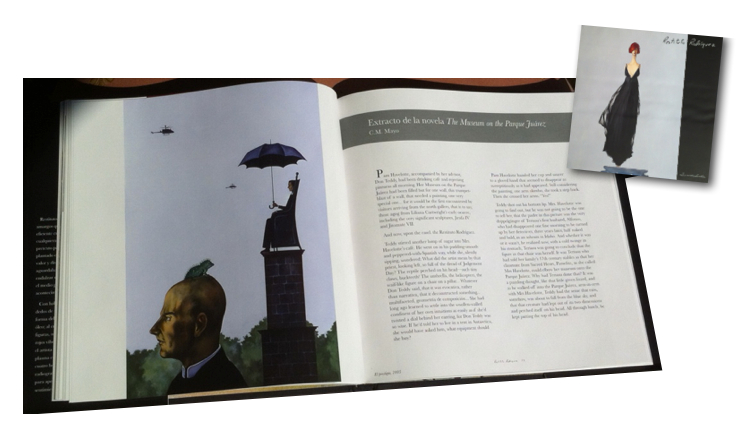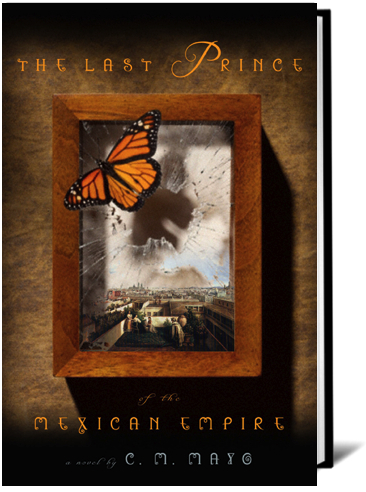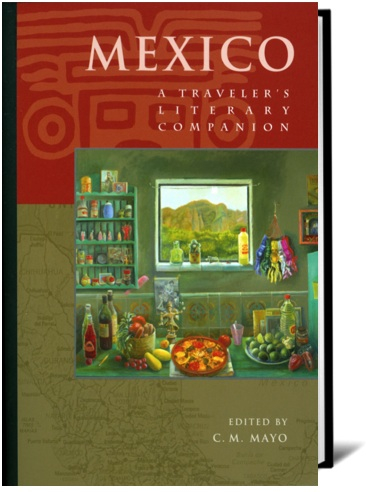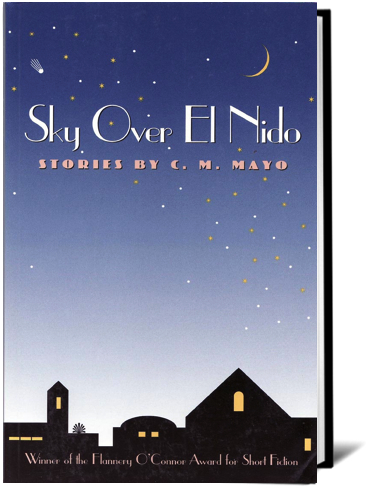
|
Restituto
Rodríguez, Surrealista
Edited by Araceli Ardón
The open page shows "El Prestigio," 2005
and the text of C.M. Mayo's
"Excerpt
from the novel The Museum on the Parque Juárez"
|
| NOTE FROM MY
BLOG, January 19, 2015: |
Really, I am
at work on my
book about Far West Texas
(I don't plan to interrupt it again as I did to write Metaphysical
Odyssey into the Mexican Revolution), but well, actually, I am at work on
a novel, if at a glacial pace. It's a comedy of manners set in
an imaginary town with some features (such as the Parque Juárez)
that might sound like San Miguel de Allende... or Antigua...
or someplace west of Peru in an alternative universe overgrown
with ferns.
Anyway, I am
delighted to announce that my amiga the Mexican writer Araceli
Ardón
has brought out a gorgeous anthology of artworks by surrealist
painter Restituto
Rodriguéz
paired with original works, apropos of those artworks, by Mexican
writers including Araceli Ardón, Agustín Cadena, Mónica Lavín, Silvia Molina, Pedro
Angel Palou...
and Yours Truly, with an excerpt from the novel-in-progress.
(Restituto Rodríguez,
Surrealista was published by the State of Querétaro, Fondo
Editorial Querétaro, Código Áureo, Valverde
Internacional, and the City of San Juan del Río, Querétaro.
ISBN 978-607-96622-0-2).
Herewith:
|
Excerpt from
the novel The Museum on the Parque Juárez
By C.M. Mayo |
Pam Havelotte, accompanied by her advisor, Don Teddy, had been
drinking café and rejecting pinturas all morning. Her
Museum on the Parque Juárez had been filled but for one
wall, this trumpet-blast of a wall, that needed a painting, one
very special one... for it would be the first encountered by
visitors arriving from the north gallery, that is to say, those
agog from Liliana Cartwright’s early oeuvre, including the
very significant sculptures, Jirafa IV and Jitomate
VII.
And now, upon the easel: the Restituto Rodríguez.
Teddy stirred another lump of sugar into Mrs. Havelotte’s
café. He went on in his pudding-smooth and peppered-with-Spanish
way, while she, silently sipping, wondered: What did the artist
mean by that priest, looking left, so full of the dread of Judgement
Day? The reptile perched on his head—such tiny claws, buckteeth!
The umbrella, the helicopters, the waif-like figure on a chair
on a pillar... Whatever Don Teddy said, that it was evocativa,
rather than narrativa, that it deconstructed something...
multifaceted, geometría de composición...
She had long ago learned to settle into the woollen-walled comfiness
of her own intuitions as easily as if she’d twisted a dial
behind her earring, for Don Teddy was so wise. If he’d told
her to live in a tent in Antarctica, she would have asked him,
what equipment should she buy?
Pam Havelotte handed her cup and saucer to a gloved hand that
seemed to disappear as surreptitiously as it had appeared. Still
considering the painting, one arm akimbo, she took a step back.
Then she crossed her arms. “Yes!”
Teddy shot out his bottom lip. Mrs. Havelotte was going to find
out, but he was not going to be the one to tell her, that the
padre in this picture was the very doppelgänger of Teriasu’s
first husband, Alfonzo, who had disappeared one fine morning
to be turned up by her detectives, three years later, half naked
and bald, in an ashram in Idaho. And whether it was or it wasn’t,
he realized now, with a cold twinge in his stomach, Teriasu was
going to conclude that the figure in that chair was herself.
It was Teriasu who had sold her family’s 17th century stables
so that her classmate from Sacred Heart, Pamelita, as she called
Mrs. Havelotte, could elbow her museum onto the Parque Juárez.
Why had Teriasu done that? It was a puzzling thought, like that
little green lizard, and as he walked off into the Parque Juárez,
arm-in-arm with Mrs Havelotte, Teddy had the sense that rain,
somehow, was about to fall from the blue sky, and that that creature
had lept out of its two dimensions and perched itself on his
head. All through lunch, he kept patting the top of his head.
|
|
Here is my translation
of the text on the back of the book, Restituto Rodríguez,
Surrealista
Restituto Rodríguez
was born in 1931 in an old house in the Historic Center of San
Juan del Río, Querétaro. He studied accounting
and worked in various governmental agencies until his retirement,
at which time he embarked upon a road of no return, dedicating
himself body and soul to painting, a jealous lover that had bewitched
him since childhood.
The two genres of his work have been portraits and surrealism,
the language of which he uses with great fluency. In his youth,
he imbibed the works of masters in this genre such as Remedios
Varo, Leonora Carrington, Salvador Dalí and René
Magritte. In time he worked out his own style; today, his work,
an audacious proposal, is completely derived from his personal
experience, nurtured by the events of eight decades in which
he has lived with his eyes open and soul unveiled.
This book contains a selection of his works together with the
valuable contribution of 20 outstanding writers, offering poetry
and short fiction from the United States, Hungary, Spain, Panama
and various parts of Mexico, all inspired by the fantastic images
created by Restituto Rodríguez.
|
 |
| |
PRAISE
FOR C.M. MAYO'S
THE LAST PRINCE OF THE MEXICAN EMPIRE
A Library Journal Best Book, 2009
|
 "Once upon a time,
there was a little half-American boy who briefly became heir
to the Mexican throne—until his distraught parents sued
the doomed Emperor Maximilian for his return. As in the best
historical fiction, Mayo's sparkling first novel transforms a
forgotten historical footnote into a spellbinding, heartbreaking
tale filled with drama and fascinating characters." "Once upon a time,
there was a little half-American boy who briefly became heir
to the Mexican throne—until his distraught parents sued
the doomed Emperor Maximilian for his return. As in the best
historical fiction, Mayo's sparkling first novel transforms a
forgotten historical footnote into a spellbinding, heartbreaking
tale filled with drama and fascinating characters."
Library
Journal
"It is a hefty, sprawling
work, more than 400 pages long, but at no point does it begin
to sag under its own weight. Perhaps because its spread is solidly
supported by facts, Mayo's intricate plot trips along at a natural,
inexorable pace, easily traveling the sweeping map she has laid
out for it, from Washington to Mexico City and all the way to
the imperial halls of Europe... a swashbuckling, riotous good
time, befitting the fairy-tale promise of the opening sentence."
Austin
American-Statesman
|
PRAISE
FOR C.M. MAYO'S
MIRACULOUS AIR |
 "With elegant prose
and an artist's eye for detail, Mayo may just have written one
of the best books ever about Baja California. Highly recommended" "With elegant prose
and an artist's eye for detail, Mayo may just have written one
of the best books ever about Baja California. Highly recommended"
Library
Journal
"Ay,
if only I had been at C.M. Mayo's side in her rendezvous through
Baja California... My recourse is her joyful, intellectually
sparkling chronicle"
Ilan
Stavans,
author of The Hispanic Condition
"A
breathtaking vision of the past, present, and future of [Baja
California]... Meticulously researched... a valuable combination
of historical and social study"
El
Paso Times
"A luminous exploration
of Baja California, from its southern tip at Cabo San Lucas to
its 'lost city' of Tijuana... [Mayo] takes the fiction writer's
impulse and blends it with the instincts of a journalist to create
a work of nonfiction that elides into modern myth"
Los
Angeles Times Book Review
|
PRAISE
FOR C.M. MAYO'S
MEXICO: A TRAVELER'S LITERARY COMPANION |
 "one
of the outstanding contemporary works on this country" "one
of the outstanding contemporary works on this country"
David
Huerta, El Universal, Mexico City
"This
is a book to throw in a suitcase or mochila (backpack)
on the way to Mexico or just settling into a favorite patio chair.
It will open your eyes, fill you with pleasure and render our
perennial vecinos a little less distante."
Los Angeles
Times Book Review
"This delightful
anthology . . . allows readers who do not have roots in Mexico
or who have never traveled there a glimpse into the rich diversity
of people and landscape. For travelers, these selections enhance
exploration and offer vistas beyond the scope of the usual tourist
guide. For other readers, they provide a clearer understanding
of the cultural and social forces that shape today's Mexico.
Highly recommended."
Library
Journal
"Discovering
it was like opening a door and walking into a brightly lit room
filled with all kinds of literary treasures"
Mexico
Connect
|
PRAISE
FOR C.M. MAYO'S
SKY OVER EL NIDO |
 "A remarkable literary
debut... tautly fashioned prose, alive with myriad turns of phrase
as on-target as they are idiosyncratic." "A remarkable literary
debut... tautly fashioned prose, alive with myriad turns of phrase
as on-target as they are idiosyncratic."
Publisher's
Weekly (starred
review)
"C.M. Mayo
writes some of the most exquisitely fashioned, perfectly measured
prose alive in the world today. Her stories glitter with delicious
odd details. They feel electrically charged, richly mysterious,
and rhythmic. I love her layering of cultures, her offbeat humor,
her potent instinct for voices. Bravo! Captivating! Yes, yes,
yes!"
Naomi
Shihab Nye
"The
haywire circuits of our whole electrically but not ethically
connected global village stand exposed in Mayo's work. Sky
Over El Nido won the 1995 Flannery O'Connor Award for Short
Fiction. I am not surprised."
David
Toolan, S.J., Commonweal
"Sky
Over El Nido is a breath-taking first collection... These
stories are vibrant, strange, loaded with off-beat humor, exquisite
detail, and delivered with near-perfect pitch. Sky Over El
Nido shimmers with life."
The
Virginia Quarterly Review
|





